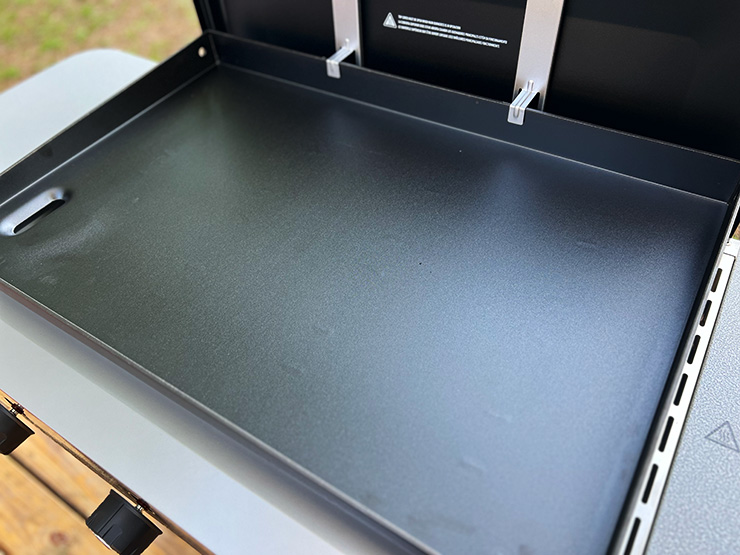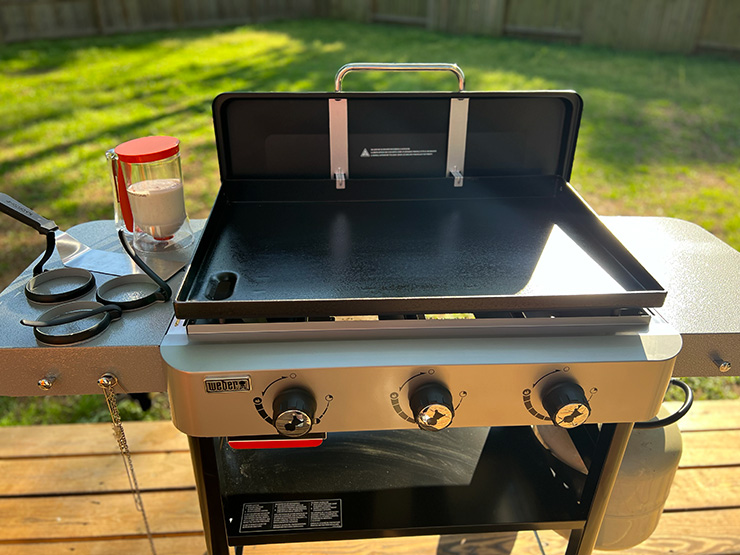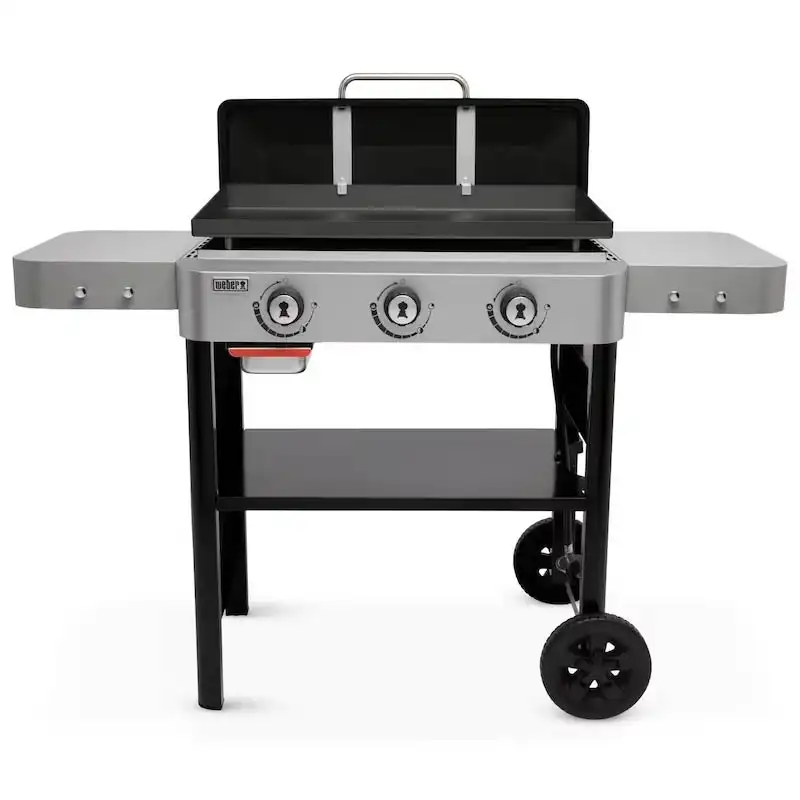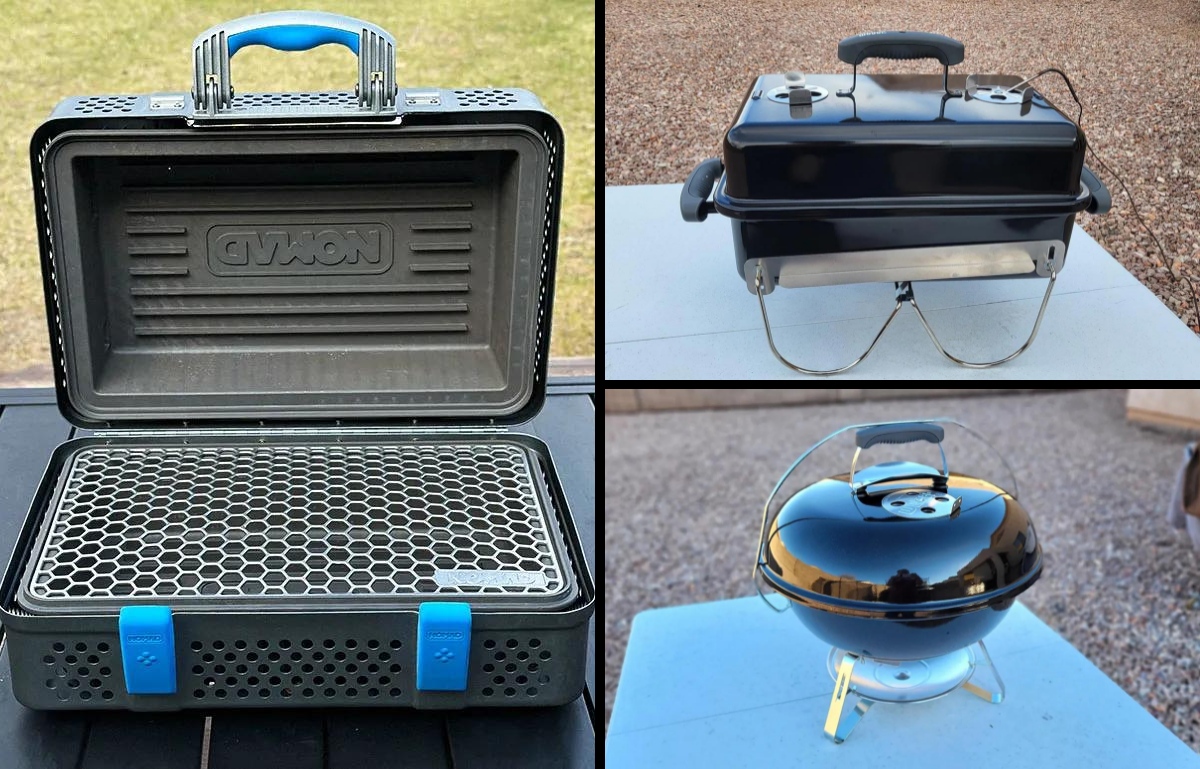Weber Griddle 28” Review: How Does the New Weber Griddle Stack Up Against the Competition?

Weber is one of the most popular names in outdoor cooking and with the rise in popularity of griddle cooking in recent years, it was simply a matter of time before
I’m going to be breaking down the ins and outs of the new
- Sleek and attractive design
- Easy-to-light Snap Ignition System
- Lightweight and easy to transport
- Flimsy lid
- Poorly located grease trap
- Uneven cooking surface
- Low-cost cooktop material
Weber sent me this grill for free in exchange for an honest review. All thoughts and opinions are my own.
Weber Griddle 28” overview and first impressions
Weber has offered various griddle inserts and accessories for their other grills in the past, but in January 2023 they announced the launch of their standalone griddle.

After the assembly, I was impressed by the design of the
Weber Griddle 28″ specifications:
| Dimensions | 53.55”W x 41.45”H x 23.94”D |
| Weight | 110 lbs |
| Griddle Surface Material | Hot-rolled steel |
| Cookbox Material | Aluminized steel |
| Burners | 3 x 12,000 BTU burners |
| Total BTU | 36,000 |
| Total Cooking Area | 504 sq. in. |
| Fuel Type | Liquid propane (tank sold separately) |
| Price | Check Latest Price |
What I like:
- Sleek and attractive design
- Easy-to-light Snap Ignition System
- Lightweight with large wheels for easy transportation
What I don’t like:
- The lid is flimsy and poorly designed
- Grease trap is offset from the edge of the cooking surface, making it difficult to use
- Grease, oil, and water pool in the corner due to uneven cooking surface
- Hot-rolled steel cooktop (vs. higher quality cold-rolled steel)

The
The three burners work independently of each other, allowing you to set various heat levels across the cooking surface and the griddle heats up relatively quickly reaching temperatures over 500°F.
Unboxing and assembly
Assembling the
The included instructions are easy to follow and give you a detailed, step-by-step description of what you need to do to assemble the grill. I liked that
As I mentioned before, the grill is extremely lightweight, so the assembly is easy for someone to do on their own without needing a helping hand.
The cooking surface
The griddle offers a 504 sq. in. cooking surface, which is more than adequate to cook for a family or small group from a size perspective. One thing that did not impress me is that
The issue with hot-rolled steel for a griddle is that the steel is rolled at a high temperature (typically over 1700°F) and then allowed to cool after manufacturing. This technique can result in non-uniform shrinkage of the steel and less control over the final product’s size, shape, and finish.

Cold-rolled steel is more expensive to process, which is why I assume that
Cold-rolled steel will result in a harder and stronger product, and I was disappointed to find that
One issue I struggled with while cooking on the
While it looks flat to the naked eye, I immediately noticed that the uneven surface was an issue once I started cooking.
The Weber Griddle lid
Another major issue that I have with the build quality of the
Plus, the lid cannot be placed on the griddle during cooking. It’s essentially just a little piece of aluminum that covers the griddle surface when the grill is not in use, but from an application and quality standpoint, it leaves a lot to be desired.

The grease trap
The final issue I found with the
As I tried to scrape grease, oil, and debris into the trap with my spatula, I got frustrated because the grease would pool in the corner space between the edge of the griddle and the hole itself. I don’t understand why they would put the grease trap so far from the edge of the griddle, and for me, that was a frustrating detail, albeit a small one.

Weber Griddle 28” overall design & appearance
Overall, the
There are no bells and whistles that we’ve come to expect from other griddle. The silver and gray color scheme is a bit boring, and this grill definitely isn’t a statement piece for your backyard.
The grill’s body is made from lightweight aluminized steel, and the side trays are nice to have, but don’t seem to be exceptionally sturdy.
I like that

The griddle surface gets hot quickly and seems to maintain a steady temperature during the cooking process.
I feel like
Seasoning and preparation of the Weber Griddle
As with most griddles, the cooktop surface of the

Step 1: Clean and dry your cooking surface
The first step is to clean your griddle to remove any chemicals or debris left behind from the manufacturing process. Warm water, a bit of dish soap, and a sponge does the trick perfectly.
After you’ve cleaned your griddle, it’s important to wipe it down with a dry cloth to remove any water before you are ready to add oil and start seasoning the cooktop.
Step 2: Coat the surface in oil
Using a neutral oil with a high-smoke point, you want to coat the entire surface of your griddle in oil including the sides and edges.
Step 3: Fire up the griddle
Turn all three burners to medium heat and let the griddle preheat fully. You will start to see the oil begin to smoke as the griddle reaches higher temperatures, and the surface of the griddle will gradually darken as the seasoning process happens. After about 15 minutes, the griddle should stop smoking and your first layer of seasoning is complete.
Step 4: Repeat the process
To ensure that you have a solid layer of seasoning on your griddle, you want to repeat step #3 at least 3 to 4 times to build a good layer.
Need more tips on seasoning your griddle? Check out our article on How to Season a Griddle or Blackstone.
Cooking on the Weber Griddle 28”
Now, let’s get to the fun part – how does the
The Bread Test
If you’ve read any of my other grill reviews, you know I always like to start with a good, old-fashioned bread test. It’s a great way to test a grill for hot spots and determine how evenly the cooking surface or grates distribute heat.
I preheated the griddle to medium-high heat and let it preheat for about 15 minutes. Then I laid slices of white bread across the entire surface of the griddle, let them cook for about 2-3 minutes, then gave them a flip to see how evenly the griddle cooks.

Now, I felt that this test was particularly important for this griddle because
After I flipped over my bread (or is it considered toast at this point?), I did find some variance in temperature across the surface of the griddle. The center of the griddle seemed to keep a very even temperature across the entire surface, but the edges – especially the bottom edge, didn’t give me the same uniform toasting as the center.

Overall, I would say the
Cooking on the Griddle
When I get a new griddle, I always like to start by cooking bacon. I find that bacon grease is a great way to ensure your griddle is fully seasoned (plus, who doesn’t love bacon?!). I also decided to cook some sausage and eggs to see how the griddle performed with a variety of foods. Breakfast and griddle cooking go hand in hand, after all!

I would say the
It maintained a steady heat when I had the burners set to medium. I did find that if I tried to push the heat up past the medium setting, the griddle got REALLY hot and made it hard to cook on (yes, I admittedly burned a batch of pancakes).
I placed the three eggs in ring forms on the far right side of the griddle, and I noticed that the eggs in the center and at the top of the griddle cooked perfectly, but I struggled to cook the one toward the bottom right of the griddle – indicating that there is a bit of a cool spot there.
The egg at the bottom didn’t set as quickly as the others, and I had some uneven cooking there.

The bacon and sausage cooked perfectly, and I was able to get nice, crispy bacon in just about 10 minutes or so.
The biggest issue I had with cooking on the griddle was that I found the cooking surface slightly uneven.
I didn’t notice it with my naked eye, but as I started to accumulate bacon grease on the surface of the griddle, it started to pool in the bottom right corner – opposite side of where the grease trap is located.
When I was done cooking and working on scraping all the grease into the grease trap, I struggled a bit to move it against gravity up to where the grease trap is located, and I got a bit frustrated with the unlevel surface at this point.

Also, as I mentioned before, the grease trap opening is offset from the edge of the griddle by about 2 inches and leaves a significant gap from the edge of the cooking surface to the grease trap hole. This caused grease and debris to get stuck in the corner of the griddle as I scraped it with my spatula.
Final thoughts: should you buy the Weber Griddle 28”?
If you are a tried-and-true
My biggest issue with the
Also, if you’re going to produce a griddle as basic as this one, I think the build quality becomes a lot more critical and there were issues with build quality that I struggled to look past. The uneven cooking surface and awkward location of the grease trap opening are the two major issues that I think need to be addressed.
For a basic, simple griddle, I think the
If you’re still unsure which griddle is right for you, check out our Best Gas Griddles roundup to get the scoop on some other options today.
- Sleek and attractive design
- Easy-to-light Snap Ignition System
- Lightweight and easy to transport
- Flimsy lid
- Poorly located grease trap
- Uneven cooking surface
- Low-cost cooktop material








